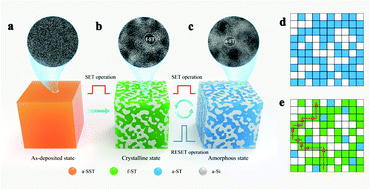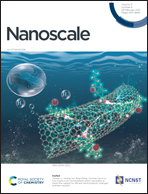Reversible switching in bicontinuous structure for phase change random access memory application†
Abstract
SiSbTe phase change materials (PCMs) have excellent thermal stabilities. Their properties and microstructures are strongly affected by their Si content. Si3.3Sb2Te3 (SST) gives the best electrical performance, at Si contents of around 40%. Here, use of a combination of an advanced three-dimensional (3D) tomography technique and transmission electron microscopy clearly showed that a crystallized SST film has a uniform equiaxed-structure in 3D space, and consists of a reversible Sb2Te3 (ST) phase and an amorphous (a-) Si phase, which are well nested with each other. The a-Si nest localizes structure switching and diffusion of the host element in the nano-area. The most innovative aspect is significant retention of the metastable face-centered cubic (f-) ST phase, even above 370 °C, in this bicontinuous system. Specifically, the a-Si frame is stable and the ST phase switches between a- and f-structures under external stimulation. This promotes faster SET speed and low-power RESET consumption. Our results give new insights into PCM systems. They suggest that bicontinuous structures are potential candidates for use in phase-change random access memory devices, especially in automotive electronics applications that require a high data retention ability.



 Please wait while we load your content...
Please wait while we load your content...